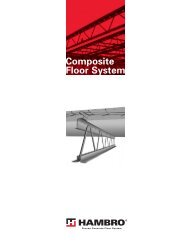Create successful ePaper yourself
Turn your PDF publications into a flip-book with our unique Google optimized e-Paper software.
DESIGN PRINCIPLES AND CALCULATIONS - COMPOSITE DESIGN<br />
FLEXURE DESIGN<br />
In the past, conventional analysis of composite beam sections<br />
has been linearly elastic. Concrete and steel stresses have<br />
been determined by transforming the composite section to a<br />
section of one material, usually steel, from which stresses are<br />
then determined with the familiar formula, f = My / I, and then<br />
compared to some limiting values which have been set to<br />
ensure an adequate level of safety. Although this procedure<br />
is familiar to most engineers, it does not predict the level of<br />
safety with as much accuracy as does an ultimate strength<br />
approach which is based on the actual failure strengths of the<br />
component materials.<br />
It is now known that the flexural behavior at “ultimate” failure<br />
stages of composite concrete/steel beams and joists is similar<br />
to that of reinforced concrete beams - the elastic neutral<br />
axis begins to rise under increasing load as the component<br />
materials are stressed into their inelastic ranges. The typical<br />
stress-strain characteristics of the concrete and steel components<br />
are shown in fig. 5.<br />
Concrete stress<br />
Steel stress<br />
F u<br />
F y<br />
f’ c<br />
Inelastic<br />
range<br />
Elastic<br />
range<br />
Inelastic<br />
range<br />
Elastic<br />
range<br />
E y<br />
Concrete strain<br />
Steel strain<br />
Fig. 5<br />
Concrete and Steel Stress - Strain Curves<br />
The various loading stages of the <strong>Hambro</strong> composite joist are<br />
indicated in fig. 6. As load is first applied to the composite<br />
joist, the strains are linear. The “elastic” neutral axis, concrete<br />
and steel stresses can be predicted from the conventional<br />
transformed area method. Generally speaking, the <strong>Hambro</strong><br />
composite joist behaves in this “elastic” manner when<br />
subjected to the total working loads. With increasing load,<br />
failure always begins initially with yielding of the bottom chord.<br />
In (a), all of the bottom chord has just reached the yield stress,<br />
F y . The maximum concrete strains will likely have just<br />
progressed into the inelastic concrete range, but the maximum<br />
concrete stress will still be less than 0.85 f’ c .<br />
With a further increase in load, large inelastic strains occur in<br />
the bottom chord and the ultimate tensile force, T u , remains<br />
equal to A s F y . The strain neutral axis rises, as does the<br />
centroid of the compresssion force. Part (b) depicts the stage<br />
when the maximum concrete stress has just reached 0.85 f’ c .<br />
At this stage, the ultimate resisting moment has increased<br />
slightly due to a small increase in Iever arm.<br />
7



